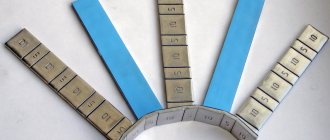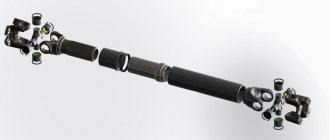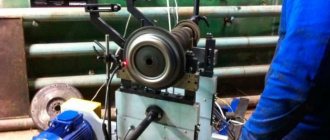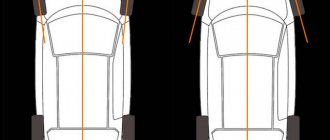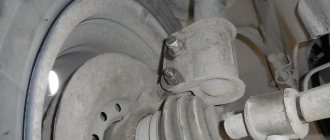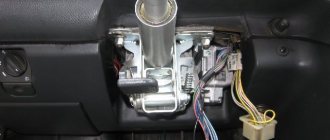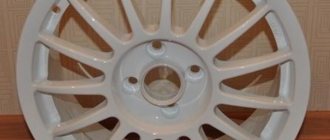Wheel balancing is eliminating wheel imbalance car by displacing the center of rotating masses as close as possible to the axis of its rotation. The need for such a procedure arises when the mass of tires and wheels is displaced relative to their axis of rotation. Because the imbalance is transmitted to the car’s suspension elements.
Balancing the wheels on a car prevents excessive vibration of the steering wheel and body while driving, and also helps prevent deterioration in handling and premature wear of wheel bearings, ball joints and suspension silent blocks.
In this article we will talk in detail about when you need to balance wheels, how this procedure is carried out and whether you can do it yourself, as well as answer other frequently asked questions about wheel balancing.
What affects car wheel balancing?
It is almost impossible to ensure an absolutely accurate mass distribution relative to the center of the tire and wheel. Therefore, a slight imbalance is present even in new products. A deviation of a couple of tens of grams already has a negative impact on the behavior of the car during operation, giving rise to such problems as:
Example of wheel imbalance
- steering wheel beating and body vibration when driving;
- deterioration of controllability, deviation to the side from the correct trajectory;
- premature wear of wheel bearings, ball joints, suspension silent blocks;
- uneven and accelerated tire tread wear.
Eliminating this imbalance and related problems through compensating elements is exactly what wheel balancing does .
The symptoms and consequences of operating a car with unbalanced wheels directly depend on how much and in which direction the mass of the assembled wheel is shifted relative to the center of the rotation axis. Depending on this, three types of imbalance .
When is wheel balancing needed: causes and types of imbalance
| Type of imbalance | What causes | How does the car behave? | How the imbalance is corrected |
| Static (vertical) | Imbalance of the wheel vertically relative to the axis of rotation. | Radial runout of the wheel, slight swaying of the body on a vertical plane on a flat road, intense wear of the tire tread in one area across the entire width. | Static leveling is the installation of a counterweight at a point opposite to the point where the unbalanced mass is located. |
| Dynamic (longitudinal) | Displacement of the center of mass along the axis of rotation of the wheel. | Steering wheel runout at speeds of 40 km/h (tire imbalance on the front axle) or 100 km/h (tire imbalance on the rear axle), accelerated tread wear along the circumference on one side. | Dynamic compensation – placing weights to correct imbalances on the disc. |
| Combined | Imbalance in the vertical and horizontal planes. | Signs of dynamic and static imbalance are combined. | Use of compensating weights. |
a combined imbalance is most often observed , and the installation location of the compensation weights is chosen in such a way as to ensure balance on both axes. You can achieve the best result by changing the position of the tire on the rim. Sometimes this allows you to do without the use of cargo, but it requires significantly more time.
Elimination of wheel imbalance is possible with the help of microbeads - special granules poured inside the tire. However, due to the high cost of the latter and insufficient accuracy on small-diameter wheels, this method is not widely used.
Important Balancing Information
When balancing wheels, certain rules must be followed. If you ignore them, the result will noticeably worsen.
- It is necessary to remove lead weights from the rim of the disc;
- The disk is cleaned of dirt;
- It is checked how well the tire is installed on the rim;
- If there are plastic caps on the wheels, the wheel balancing is disrupted.
You can often hear the opinion from car enthusiasts that balancing does not require special attention, and the quality of car operation does not depend on it in any way. If balancing is incorrect, you may encounter the following problems:
- Tires wear unevenly;
- Individual suspension elements are subject to accelerated wear;
- The vehicle's handling is noticeably reduced;
- You can feel the steering wheel beating;
- When driving, the car may pull to the side;
- The braking distance increases noticeably;
- Road grip is reduced;
- The body begins to vibrate;
- The degree of comfort when using the car is noticeably reduced;
- Car costs increase significantly.
How often should wheels be balanced?
The recommended frequency of wheel balancing is every 10–15 thousand kilometers . It is advisable to carry it out every time you change wheels seasonally. However, sometimes additional procedures may be required.
When do you need to balance your wheels more often?
How often should you do balancing: video
- After tire fitting . A prerequisite is to balance the wheel after each installation of a tire on a rim (including after repair) due to changes in their relative position.
- After falling into a hole or hitting an obstacle at high speed . Even if there is no visible damage to the tire or wheel, the balance of the wheel may be affected.
- During frequent braking with wheel locking on a car without ABS . Sharp braking leads to uneven tread wear, resulting in changes in mass distribution.
- With an aggressive driving style . Sharp acceleration and braking, and cornering, accelerate tire wear, thereby disturbing the balance of the wheels.
- When driving on bad roads . On roads with damaged or gravel surfaces, as well as off-road, tires also wear out faster.
- If vibrations occur in the steering wheel . Vibrations and beating of the steering wheel are one of the signs of imbalance.
- After the car has been idle for a long time . If the car has been sitting motionless for six months or more, then deformation of the rubber is inevitable.
How often to balance wheels also depends on the characteristics of the tires and wheels:
- Low profile tires need to be balanced more often as they are lighter and more susceptible to damage.
- The wider the tire relative to the diameter of the disc, the more susceptible it is to dynamic imbalance.
- Summer tires need balancing less often than winter tires. Winter tires are softer, so after warming up they wear out faster when braking and on bad roads.
- Studded tires must be additionally balanced if the studs are partially lost.
Is it possible not to balance the wheels when changing them?
Drivers often have a question: is it necessary to do balancing when replacing wheels and tires seasonally? If you have one set of wheels, the answer is clear: balancing is required every time the tires are reinstalled. If the second set of tires is on separate discs, then it all depends on the storage conditions of the rubber. Wheels may not be balanced if the following factors are met:
- Since the previous balancing, the tires have traveled less than 10 thousand km;
- before the last change of these wheels there were no vibrations or beating in the steering wheel;
- the wheels were stored in compliance with the rules: in a suspended state, maintaining pressure and without sudden temperature changes.
What is the risk of steering wheel beating due to improper balancing?
Steering wheel wobble if the wheels are not balanced correctly can lead to quite sad consequences: - you can forget about good handling and driving safety - the steering will gradually break down - the shock absorbers will fail - you will have to change the step bearings and other suspension parts. All this happens as a result of vibration spreading throughout the body due to wheel imbalance. It should be noted that steering wheel wobble can be caused by both poor balancing and defects in the disc and tires (damage to the cord, hernia, etc.). But we can say with almost absolute certainty that if the steering wheel wobbles at high speeds, the reason is an imbalance of the front wheel, and the car’s drive does not matter at all. Rear wheel imbalance is usually not displayed on the steering wheel.
Most often, the problem of steering wheel runout occurs after a seasonal tire change.
Many drivers do not pay any attention to how and on what equipment the wheel balancing procedure is carried out.
And this is very important. For example, the result of balancing can be reduced to zero after 200-300 km, if the tire shop did not wash the wheel well during balancing - the dirt will fall off and the wheel will again be unbalanced
Often the problem of steering wheel beating occurs due to the fact that a low-quality weight is installed. As a result, when exposed to centrifugal force, it will simply come off and the steering wheel will immediately manifest itself.
For example, the result of balancing can be reduced to zero after 200-300 km, if the tire shop did not wash the wheel well during balancing - the dirt will fall off and the wheel will again be unbalanced. Often the problem of steering wheel beating occurs due to the fact that a low-quality weight is installed. As a result, when exposed to centrifugal force, it will simply come off and the beating of the steering wheel will immediately manifest itself.
When assembling wheels, correct, high-precision balancing is a guarantee that you will be spared the problem of steering wheel beating and its unfortunate consequences
That is why special attention should be paid to such a seemingly simple procedure as wheel balancing. It is not particularly expensive, and saving on it is simply not advisable, since as a result of poor-quality, incorrect wheel balancing and, as a result, steering wheel beating, you will have to spend money on expensive repairs
Correct wheel balancing: how to recognize?
The wheel must have weights installed on both the internal and external sides. If it is impossible or does not want to install them during the disc phase, the weight is installed as close as possible to the outside (near the spokes) from the inside. Balancing with one weight is also possible, but due to its complexity it is rarely used. The weight to be hung (weights) should not exceed 60 grams on the wheel (new) and be located nearby. If the weight is greater, then the reason may be improper assembly of the wheel, as well as if the disk has defects (bent) or a packed tire.
The wheel balancing procedure is a recent one. Drivers neglect it because they do not know all the intricacies and advantages of the operation, remembering it only when the steering wheel begins to tremble and vibrate with every turn. The article talks about wheel balancing, what it is and why it needs to be done.
How to understand that wheel balancing is needed
An experienced driver can easily identify a significant imbalance of wheels, as it directly affects the behavior of the car.
Typical symptoms of imbalance:
Signs of imbalance in movement: video
- Vibrations and shaking of the steering wheel, progressing with speed.
- Deterioration in controllability, deviation from the correct trajectory.
- Uneven wheel noise when driving on a flat road.
- Vibrations in the rear of the car (imbalance of the rear axle wheels).
- The tire tread pattern has uneven wear and there are “bald spots” on it.
Similar symptoms can occur with steering and suspension faults. Therefore, if balancing does not help eliminate the problems, then these components should be diagnosed.
The need for balancing is indicated by the presence of defects in tires and wheels that were not previously present during a visual inspection.
The principle of balancing wheels on a car
The general principle of wheel balancing is to detect deviations from the uniform distribution of mass relative to the center of the wheel and eliminate them by moving the tire and wheel and/or adding weights. If there are disc deformations, they are first corrected, and only then the balance is restored. Before performing the procedure, it is necessary to wash the surface of the wheel and remove small stones and other objects from the tread that may affect the weight distribution.
To perform vertical balancing, you need to find the lightest points on the circumference of the wheel and weigh them down. For longitudinal balancing, it is necessary to detect points that cause a displacement of the vectors of inertia forces, and similarly balance them by hanging weights. Tire offset helps less in this case, because it is usually the tire, and not the disk, that is more involved in causing the imbalance.
How to do wheel balancing
There are 4 main ways to balance car wheels, depending on the equipment:
Balancing wheels on professional equipment: video
- Static (manual) balancing . The wheel is mounted on an axle that allows free rotation and allows detection of mass displacement. To search for statistical imbalance, the wheel rotates in the vertical plane, while dynamic and combined imbalances rotate in the horizontal plane. If there is an imbalance, the wheel will constantly fall towards the point of overweight. The technology is simple and accessible, but has low accuracy ; the quality highly depends on the qualifications and experience of the master. Today, such a service is not provided by professional service stations, but can be found in garage workshops.
- Dynamic balancing on a stand . The wheel is fixed to the axis of the balancing stand, after which it is rotated, during which sensors detect and measure the imbalance. Next, the operator independently or based on the stand’s prompts (if this function is available) selects their installation locations. The procedure ends after the imbalance is zero.
- Automatic powder balancing . The wheels are filled with a special powder (also known as granules and beads), which, under the influence of centrifugal forces, is distributed over the inner surface of the tire and balances the wheel. Under the influence of a static electric charge generated by friction, the powder adheres to the wheel and is held at the desired points. The method allows you to quickly balance the wheels of heavy equipment, it is relatively simple, but the granules themselves are expensive, their correct dosage is required depending on the size of the wheel and the magnitude of the imbalance.
- Final balancing on the car . The car wheel is jacked up and a balancing device equipped with a roller and sensors is attached to it. The roller spins the wheel to speeds of about 90–100 km/h, and sensors record the magnitude of the vibrations that occur and calculate the load attachment points and their mass. Since the hub, the brake drum or disc, and the drive axle shaft rotate together with the wheel, this balancing technology makes it possible to balance all arising inertial forces as accurately as possible and eliminate runout. The advantage of the method is high accuracy, the disadvantages are low prevalence and high price.
The table below presents a comparison of wheel balancing methods, which will help you weigh their pros and cons and find out which balancing of passenger car wheels will be the best choice, and what is the best way to balance truck wheels.
How wheels are balanced: description and comparison of technologies
| Balancing method | Advantages | Flaws | Peculiarities | Average price for the season* 21–22, rub. |
| Installing balance weights manually |
|
| Due to its low accuracy, the method is suitable for balancing small passenger wheels on cars moving at a speed of no higher than 100 km/h. | Free (only costs for weights) if done independently. Almost never found in professional services. |
| Adding balancing powder to the tire |
|
| Suitable only for vehicles with wheels with a diameter of 15 inches or more due to low accuracy. |
|
| Dynamic balancing of a car on a stand |
| Weights get lost when driving on bad roads and during washing, spoiling the aesthetic appearance of the wheel | The most common balancing method. Optimal for cars of all classes. |
|
| Final wheel balancing directly on the car |
|
| Recommended for fast sports cars, not available for heavy equipment (trucks, buses). |
|
*Average prices are indicated for two balancing of 4 wheels per year, when switching from summer tires to winter tires and vice versa.
**Before final balancing, a “rough” dynamic balancing may also be required to eliminate the most pronounced imbalance.
How to balance a set of tires at home?
DIY balancing device
If a tire service is unavailable or if you want to save money, you can balance the wheels yourself using a machine that can be assembled in a garage. The simplest garage balancing stand consists of a hub securely mounted on a rigid support with a flat base.
Balancing must be done in the following order:
- Fasten the wheel, cleaned of dirt, to the hub and spin it by hand.
- During rotation, observe the beating of the rubber, the “figure eight” of the disk.
If there are strong pronounced deformations and runout, balancing is unlikely to help. - Wait until the wheel stops and is balanced, put a chalk mark at the top point.
- Turn the wheel 90 degrees (a quarter turn) in both directions several times, waiting for it to stop after each turn.
- If the wheel is in a different position each time, there is no pronounced static imbalance, it is “conditionally balanced.”
- If the mark is always at the top, the main point of imbalance has been identified, you can begin to eliminate it.
The faster the wheel returns to the top position, the more weight is needed. Its exact value can only be predicted experimentally. Without experience, you can start with a load weighing 20–30 grams. - To eliminate the imbalance, you need to hang (without fixing it securely) a weight opposite the mark and repeat step 4.
- If, after hanging the weight, the mark still appears at the top, its mass must be increased; if it now goes down, it must be reduced.
- It is necessary to adjust the weight of the weights until the wheel, after spinning 90 degrees, stops in any position. When the optimal set of weights has been selected, they can be fixed.
For a more uniform distribution of masses, you can use several weights: for example, instead of one for 40 grams on the outer side, attach 20 gram weights on the outer and inner sides opposite the mark.
The described method is a static balancing designed to shift the center of mass of the wheel as close as possible to the axis of its rotation. It allows you to eliminate very large imbalances with an accuracy acceptable for cars that do not drive fast, but is not suitable for fine adjustments of balance. This is acceptable wheel balancing for VAZ classics and other similar models.
More accurate balancing of car wheels at home is possible using a “spinning top” shaped device. The tool can be made on a lathe from a solid steel blank (moreover, steel is harder than the common ST-3) with a diameter of about 150 mm, so that the structure is monolithic and balanced.
Aluminum and other soft metals are not suitable because the ends of the spindle axle must be rigid and not deform or become dull under the weight of the wheel!
The tool should have a slight taper on one side that turns into a thread. The conical shape is needed so that the wheel self-centers when the nut is tightened.
The balancing process is carried out as follows:
Balancing a wheel at home: video
- Place the “top” in the central hole of the disk and tighten it with a nut.
- Place the wheel with the tip of the “top” on a flat, hard surface or in a stand with a recess.
- Move the wheel and release it, controlling the position in space. A balanced wheel should independently occupy a horizontal position and return to it after rocking. If there is an imbalance, it will not stay “in the horizon”.
- If an imbalance is detected, you need to take a weight and place it at the highest point of the wheel, and then repeat step 3. If the same section still rises with the load, its mass must be increased; if it begins to fall, decrease it.
- The weight of the weights is selected until the wheel on the spoke begins to take a horizontal position and returns to it after each rocking. The static balancing of the wheel is completed, and if high accuracy is not required, then it can be placed on the car. If you also need to eliminate dynamic imbalance, then you need a rigid tripod (for example, a laboratory one) with chalk and the following further actions:
- The wheel is manually spun on the top to the maximum possible speed.
- With the help of a small wooden block, lightly pressed against the upper edge of the top, the vibrations introduced during spinning are dampened.
- The tripod arm with the chalk attached is smoothly brought to the wheel rim until it makes the first contact.
- After several revolutions of the wheel (and touching the chalk), you need to stop it and see at what point the chalk touches the disk.
- At the point where the chalk touches, a weight should be secured (the weight is selected experimentally), and a second weight of the same weight should be secured on the diametrically and diagonally opposite side of the rim. This is necessary to prevent static imbalance.
- Experiment with the weights until the beating of the wheel goes away and it stops touching the chalk with one point.
Self-balancing in a garage cannot fully replace the procedure on modern equipment due to low accuracy. Therefore, if possible, it is better to visit a service station and eliminate the imbalance completely. This is more reliable, and taking into account the considerable labor required to balance large wheels, it is also much easier.
Myth: Vulcanizations ruin tires so they can be returned to them
Not a single normal tire shop, and especially during the re-shoe season, wants the client to return with a flat tire. This is extra work for which you don't get paid. And the schedule during this period is tight - there are queues. Why else would they need all this trouble? But there are situations when, when beading a wheel, the sealing compound is applied unsuccessfully (the very moment when the tire is lubricated with a special paste or, in extreme cases, with oil or soap). In this case, the tire may go flat overnight, especially if the driver immediately after changing shoes put on a load, deciding to drift in the fresh snow.
And yet we should not forget about the crookedness of some hard workers. These can inadvertently cut the rubber, and often damage the rims, especially when working with low-profile tires. Unfortunately, the market for these services does not imply professional education; there are many amateurs here, and even a schoolboy can become a tire fitter.
Basic mistakes when balancing wheels
Mistakes made when balancing wheels can result in the imbalance not being completely corrected. As a result, while driving the car, the same symptoms may occur as before the procedure.
The main signs of improper wheel balancing and how to eliminate them are presented in the table.
Poor wheel balancing: signs
| Balancer error | Why is this happening | How to determine | How to fix |
| Balancing when there is dirt on the wheel or moisture inside the wheel | Adhered dirt, foreign objects lodged in the tread, and water inside the tire create inconsistent imbalances. | The wheel is not brought to zero on the machine, the imbalance is not completely eliminated | Wash the wheel thoroughly, remove foreign objects from the tread |
| Balancing a wheel with a broken tire or wheel geometry | The tire is deformed due to abnormal loads or violation of storage conditions |
| Replace a defective tire or wheel |
| The disc is deformed, its core is displaced relative to the rim, a “figure eight” appears | |||
| Incorrect torque of the hub bolt on the balancing machine | Deformation of the central center of the disk |
| Correctly fix the wheel on the machine hub and recheck the balance |
| Weak disk tightening on the machine hub | |||
| Incorrect selection of centering cone | |||
| Violation of technology for installing a tire on a disk | Misalignment of mark and nipple | Many tires have a colored manufacturer's mark at the point of lightest weight, which should be located near the valve. | Orient the tire on the rim so that the mark is near the valve |
| Poor quality side lubrication | The technician did not apply a special compound to the tire beads, which is why their fit is noticeably poor. There may be some beating noticeable to the naked eye. | Coat the beads with a sealing compound and inflate the wheel to maximum operating pressure. | |
| Insufficient pumping | The tire did not press tightly against the rim due to lack of pressure. | ||
| Misalignment when installing a wheel on the vehicle axle | Tightening bolts or nuts in a circle | The wheel on the machine shows normal balance (“to zero” or an imbalance of less than 5 grams), but after balancing the wheels there is still vibration. | Unscrew the wheel and re-tighten it to the hub, tightening the bolts or nuts crosswise diagonally, observing the torque specified by the car manufacturer |
| Uneven tightening of bolts or nuts around | |||
| Failure to secure the machine | Unreliable fixation of the machine on the ground (on a concrete base, using anchors) | In the process of spinning the wheel, the machine itself begins to vibrate, and the floor in the workshop hums. | Balance the wheel on a machine fixed in accordance with the rules for its installation and operation |
| Poor fixation of weights | The master did not fasten the weights securely enough, without pressing them to the side or without treating the surface of the disk for gluing | Soon after balancing, vibration arose again, there are no weights on the wheel, traces of fallen weights are visible (on the alloy wheels). | Re-balance the wheel and securely secure the loads. For stamped disks - check the clamping of the weights; for cast disks - clean the surface before installing the weight on an adhesive base |
| Inaccurate balancing | The master did not set the imbalance indicators to zero, leaving a slight runout | Small vibrations still appear at speed. The balancing stand shows an imbalance on one side of more than 5 grams. | Rebalance the wheel. |
| Excessive amount of cargo | The imbalance measurements were made inaccurately, which is why the number of weights and their mass were selected in excess. The tire is not aligned relative to the rim. | The total weight (for a passenger wheel) is more than 70 grams on each side. | By moving the tire relative to the disk, select their optimal position, in which less weight is needed. Have the wheel balanced on a more accurate machine and/or by a more experienced technician. |
| The tire or disk has critical deformations | Replace a defective tire or wheel |
Causes of wheel imbalance
The appearance of imbalance is possible during normal operation of the vehicle, but it is usually preceded by the following events:
- getting the wheel into a significant hole, or driving along a road with a lot of potholes;
- hitting the curb with wheels, for example, when parking poorly;
- changing tires due to seasonality or wear of old tires;
- a large amount of dirt on the wheels, for example, after leaving the city;
- tuning a car with low-quality plastic caps with disturbed weight distribution;
- shrinkage processes that occur after running in a new tire;
- restoration operations were performed on the disc;
- There was a tire puncture.
FAQ
Why is wheel balancing done?
Wheel balancing prevents wheel runout, which negatively affects handling and ride comfort, and also shortens the life of tires and suspension parts.
How often should wheels be balanced?
The average wheel balancing interval is 10,000–15,000 km. Wheels also need to be balanced when reinstalling a tire on a rim or after a severe impact to the wheel as a result of falling into a hole or hitting an obstacle.
What happens if you don't balance your wheels?
Wheel imbalance leads to increased vibrations when accelerating, deviation from the correct trajectory, accelerated wear of the tread, hub bearings, ball joints, silent blocks and other parts in the suspension.
How to check wheel balancing?
To balance wheels, it is best to use a professional stand, which will accurately detect points of imbalance and determine its magnitude.
How to recognize unbalanced wheels?
Unbalanced wheels cause vibrations and beating in the steering wheel, increase tire noise, and can cause the car to sway vertically on a flat road.
Why do you need to balance car wheels?
A completely fair and logical question. It would seem that you “put on” tires and drive a car for your own pleasure. In fact, not everything is as simple as it seems to many. Balancing a car wheel is an important procedure that directly affects traffic safety.
The procedure for balancing car wheels is performed in the following cases:
1. Replacing summer tires with winter tires or in reverse order. The rims remain the same, but the tires change. Driving on summer tires in winter is prohibited by law in many countries around the world.
This will definitely interest you Caring for a leather car interior
2.Frequently falling into a hole or hitting other obstacles can lead to wheel imbalance. Often the force of the impact turns out to be so impressive that the discs have to be replaced due to their damage.
3. Experts recommend balancing vehicle wheels after 20 thousand kilometers. The car does not always move on a well-maintained road surface. The presence of holes, potholes and other road surface defects negatively affects wheel balancing.
4. If the rubber surface is damaged, it is dismantled and repaired. It is necessary to balance the wheels after such intervention.
5.Long trips over distances of more than 2 thousand kilometers require a mandatory wheel balancing check for safety reasons.

